Liste des objets célestes les plus lointains
Cet article documente les objets astronomiques les plus éloignés découverts et validés en fonction de différentes méthodes.
Les distances aux objets éloignés, autres que ceux des galaxies proches, sont presque toujours déduites en mesurant le décalage vers le rouge cosmologique (z) de leur lumière. De par leur nature, les objets très éloignés ont tendance à être très faibles, et ces déterminations de distance sont difficiles et sujettes à des erreurs. Une distinction importante est de savoir si la distance est déterminée par spectroscopie ou en utilisant une technique photométrique. Le premier est généralement à la fois plus précis et plus fiable, en ce sens que les décalages vers le rouge photométriques sont plus susceptibles d'être erronés en raison d'une confusion avec des sources de décalage vers le rouge plus faibles qui ont des spectres inhabituels. Pour cette raison, un décalage vers le rouge spectroscopique est classiquement considéré comme étant nécessaire pour que la distance d'un objet soit considérée comme définitivement connue, alors que des décalages vers le rouge déterminés par photométrie identifient des sources très éloignées « candidates ». Ici, cette distinction est indiquée par un indice "p" pour les décalages vers le rouge photométriques.
Par distance
| Nom | z | Distance (Gal[note 1]) |
Type | Notes | |
|---|---|---|---|---|---|
| Galaxie de Schrödinger | z = 17 | 13,6 | Galaxie | Galaxie candidat, également nommée CEERS-1749. | |
| CEERS-93316 | z = 16,7 | 13,565 | |||
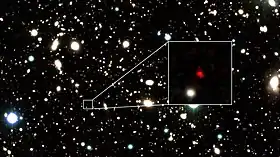 |
HD1 | z = 13,3 | 13,5 | Galaxie | Galaxie confirmée |
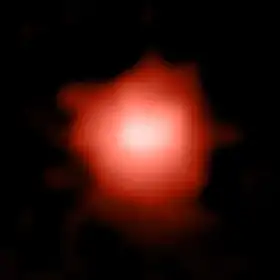 |
GLASS-z13 | z = 13 | 13,45 | Protogalaxie | Candidate |
| GLASS-17487 | z = 12.42 | 13,41 | Objet non identifier | Candidat | |
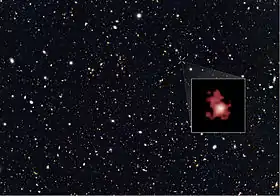 |
GN-z11 | z = 11,09 | 13,39 | Galaxie | Galaxie confirmée[1] |
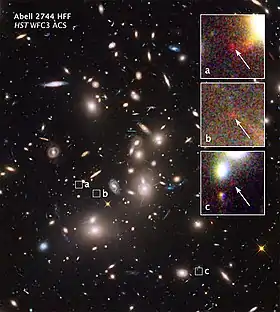 |
A2744-JD1 | z = 11,09 | 13,39 | Lentille gravitationnelle | Confirmée |
| GLASS-z11 | z = 11 | 13,3 | Galaxie | Candidate | |
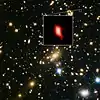 |
MACS1149-JD1 | z = 9,11 | 13,26 | Galaxie | Galaxie confirmée[2] |
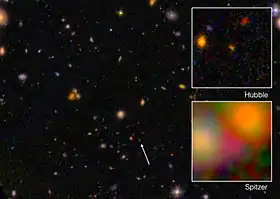 |
EGSY8p7 | z = 8,68 | 13,23 | Galaxie | Galaxie confirmée[3] |
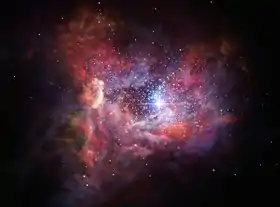 |
A2744 YD4 | z = 8,38 | 13,20 | Galaxie | Galaxie confirmée[4] |
| MACS0416 Y1 | z = 8,31 | 13,20 | Galaxie | Galaxie confirmée[5] | |
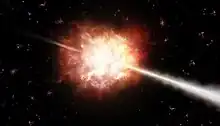 |
GRB 090423 | z = 8,2 | 13,18 | Sursaut gamma | [6] |
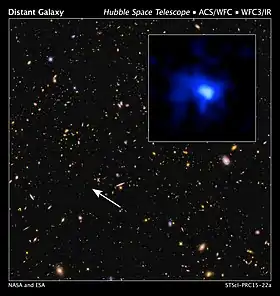 |
EGS-zs8-1 | z = 7,73 | 13,13 | Galaxie | Galaxie confirmée[7] |
| z7 GSD 3811 | z = 7,66 | 13,11 | Galaxie | Galaxie[8] | |
| QSO J0313-1806 | z = 7,64 | 13,1 - 13,2 | Quasar | ||
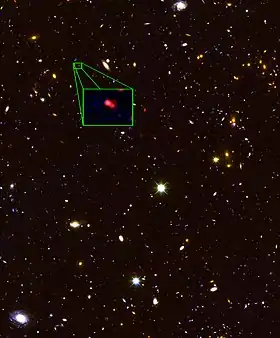 |
z8 GND 5296 | z = 7,51 | 13,10 | Galaxie | Galaxie confirmée[9] - [10] |
 |
A1689-zD1 | z = 7,5 | 13,10 | Galaxie | Galaxie[11] |
| GS2 1406 | z = 7,452 | 13,095 | Galaxie | Galaxie[12] | |
 |
SXDF-NB1006-2 | z = 7,215 | 13,07 | Galaxie | Galaxie[13] - [14] |
 |
GN-108036 | z = 7,213 | 13,07 | Galaxie | Galaxie[14] - [15] |
.jpg.webp) |
BDF-3299 | z = 7,109 | 13,05 | Galaxie | [16] |
| PSO J145.5964+19.3565 | z = 7,092 | ||||
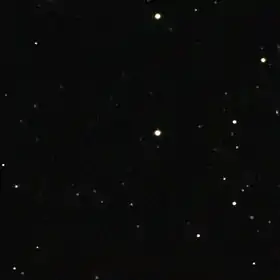 |
ULAS J1120+0641 | z = 7,085 | 13,05 | Quasar | |
| A1703 zD6 | z = 7,045 | 13,04 | Galaxie | [14] | |
| BDF-521 | z = 7,008 | 13,04 | Galaxie | [16] | |
| G2-1408 | z = 6,972 | 13,03 | Galaxie | [14] - [17] | |
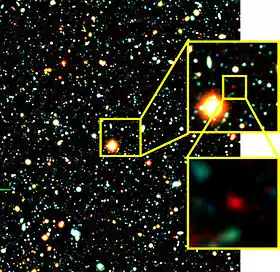 |
IOK-1 | z = 6,964 | 13,03 | Galaxie | Galaxie[14] - [18]. émetteur Lyman-alpha[19] |
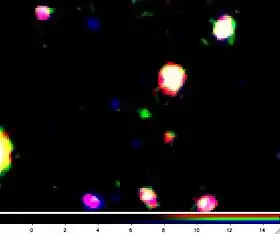 |
LAE J095950,99+021219,1 | z = 6,944 | 13,03 | Galaxie | Émetteur Lyman-alpha, galaxie ténue[20] |
| PSO J172,3556+18,7734 | z = 6,82 | Jet |
En date de 2012, il existait une cinquantaine d'objets célestes possédant un décalage vers le rouge de 8 et plus, et une centaine de candidats avec un z = 7 basés sur des décalages vers le rouge photométriques tirés du champ ultra-profond de Hubble (XDF)[21]. Ces objets ne sont pas tous listés ci-bas.
| Nom | zp | Distance (Gal[note 1]) |
Type | Remarques |
|---|---|---|---|---|
| UDFj-39546284 | zp ≅11,9 ? | 13,37 | Protogalaxie | Il s'agit d'une candidate protogalaxie[22] - [23] - [24] - [25], bien que des analyses récentes aient suggéré qu'il s'agisse probablement d'une source de décalage vers le rouge plus faible[26] - [27]. |
| MACS0647-JD | zp ≅10,7 | 13,3 | Galaxie | Candidate la plus éloignée, agrandie par l'effet de lentille gravitationnelle d'un amas de galaxies intermédiaire[28] - [29]. |
| SPT0615-JD | z = 9,9 | 13,27 | Galaxie | [30] |
| A2744-JD | ≅9,8 | 13,2 | Galaxie | [31] - [32]. |
| MACS1149-JD1 | ≅9,6 | 13,2[33] | Galaxie candidate ou protogalaxie | [34] |
| GRB 090429B | ≅9,4 | 13,14[35] | Sursaut gamma | Le redshift photométrique dans ce cas a une assez grande incertitude, sa limite inférieure étant z>7[36]. |
| UDFy-33436598 | ≅8,6 | 13,1 | Galaxie candidate ou protogalaxie | [37] |
| UDFy-38135539 | zp ≅8,6 | 13,1 | Galaxie candidate ou protogalaxie | Un décalage vers le rouge spectroscopique de z = 8,55 est donné par cette source en 2010[38], mais il serait erroné[39]. |
| BoRG-58 | ≅8 | 13 | Amas ou proto-amas | Candidat[40] |
Par type
| Type | Objet | Décalage vers le rouge | Remarques |
|---|---|---|---|
| Tout objet céleste, quel que soit son type | CEERS-93316 | z = 16.7 | Cet objet , de nature non confirmée, a un décalage vers le rouge de 16.7. Son décalage vers le rouge a été estimé par photométrie et non spectroscopie, la distance de CEERS-93316 pourrait donc changée dans les mois à venir. |
| Galaxie ou protogalaxie | |||
| Amas de galaxies | CL J1001+0220 | z ≅ 2,506 | Depuis 2016[41] |
| Superamas de galaxies | L'amas Hyperion | ||
| Quasar | J0313-1806 | z = 7,64 | [42] |
| Trou noir | [42] | ||
| Étoile, protoétoile ou cadavre stellaire | Ancêtre de GRB 090423 | z = 8,2 | Notez que GRB 090429B a un décalage vers le rouge photométrique zp≅9,4. Il est donc possiblement plus éloigné que GRB 090423[43] - [6]. |
| Objet le plus lointain découvert avec l'UKIRT Infrared Deep Sky Survey | ULAS J221728.18+001819.2 | z = 2.44 | Galaxie de Wolf-Rayet située à 11,1 milliards d'années-lumière de la Terre. |
| Étoile, protoétoile ou cadavre post-stellaire | SDSS J1229+1122 | 55 Mal | Cette supergéante bleue hypothétique illumine une nébuleuse dans la galaxie IC 3418[44]. |
| Étoile | Étoile 1 lentillée par MACS J1149+2223 ou étoile Icarus | z = 1,49 | Étoile individuelle la plus éloignée[45] - [46] - [47] - [48] |
| Amas stellaire | |||
| Système d'amas d'étoiles | Système d'amas globulaires dans une galaxie elliptique derrière NGC 6397. | 1,2 Gal | [49] - [50] - [51] - [52] - [53] |
| Jet de rayons X | Jet de PJ352–15 (en) | z = 5,831[54] | Le précédent détenteur du record était à 12,4 Gal[55] - [56]. |
| Microquasar | XMMU J004243,6+412519 | 2,5 Mal | Premier microquasar extragalactique[57] - [58] - [59]. |
| Planète | SWEEPS-11 (en) / SWEEPS-4 b[60] | 27 710 al | * Une analyse de la courbe de lumière la microlentille PA-99-N2 suggère la présence d'une planète en orbite autour d'une étoile dans la galaxie d'Andromède[61].
|
| Type | Événement | Décalage vers le rouge | Remarques |
|---|---|---|---|
| Sursaut gamma | GRB 090423 | z = 8,2 | Notez que GRB 090429B a un décalage vers le rouge photométrique zp≅9,4 et est donc probablement plus éloigné que GRB 090423. Il lui manque cependant une confirmation spectroscopique[43] - [6]. |
| Supernova à effondrement de cœur | SN 1000+0216 | z = 3,8993 | [63] |
| Supernova thermonucléaire | SN UDS10Wil | z = 1,914 | [64] |
| Recombinaison | Création du fond diffus cosmologique | z~1 000 à 1 089 | [65] |
Notes et références
- (en) Cet article est partiellement ou en totalité issu de l’article de Wikipédia en anglais intitulé « List of the most distant astronomical objects » (voir la liste des auteurs).
- 1 Gal (giga-année-lumière) = 1 milliard d'années-lumière.
Ces distances n'ont pas de signification physique directe (voir mesure des distances en cosmologie et Univers observable).
- (en) P. A. Oesch, G. Brammer, P. G. van Dokkum, G. D. Illingworth, R. J. Bouwens, I. Labbe, M. Franx, I. Momcheva, M. L. N. Ashby, G. G. Fazio, V. Gonzalez, B. Holden, D. Magee, R. E. Skelton, R. Smit, L. R. Spitler, M. Trenti, S. P. Willner, « A Remarkably Luminous Galaxy at z = 11.1 Measured with Hubble Space Telescope Grism Spectroscopy », The Astrophysical Journal, vol. 819, no 2, , p. 129 (DOI 10.3847/0004-637X/819/2/129, Bibcode 2016ApJ...819..1290, arXiv 1603.00461)
- (en) T. Hashimoto, N. Laporte, K. Mawatari, R. S. Ellis, A. K. Inoue, E. Zackrisson, G. Roberts-Borsani, W. Zheng, Y. Tamura, F. E. Bauer, T. Fletcher, Y. Harikane, B. Hatsukade, N. H. Hayatsu, Y. Matsuda, H. Matsuo, T. Okamoto, M. Ouchi, R. Pello, C. Rydberg, I. Shimizu, Y. Taniguchi, H. Umehata, N. Yoshida, « The Onset of Star Formation 250 Million Years After the Big Bang », Nature, vol. 557, no 7705, , p. 312–313 (PMID 29765123, DOI 10.1038/s41586-018-0117-z, Bibcode 2018Natur.557..392H, arXiv 1805.05966)
- (en) Adi Zitrin, Ivo Labbe, Sirio Belli, Rychard Bouwens, Richard S. Ellis, Guido Roberts-Borsani, Daniel P. Stark, Pascal A. Oesch, Renske Smit, « Lyman-alpha Emission from a Luminous z = 8.68 Galaxy: Implications for Galaxies as Tracers of Cosmic Reionization », The Astrophysical Journal, vol. 810, no 1, , p. L12 (DOI 10.1088/2041-8205/810/1/L12, Bibcode 2015ApJ...810L..12Z, arXiv 1507.02679)
- (en) Laporte, N.; Ellis, R. S.; Boone, F.; Bauer, F. E.; Quénard, D.; Roberts-Borsani, G. W.; Pelló, R.; Pérez-Fournon, I.; Streblyanska, A., « Dust in the Reionization Era: ALMA Observations of a z = 8.38 Gravitationally Lensed Galaxy », The Astrophysical Journal, vol. 832, no 2, , p. L21 (DOI 10.3847/2041-8213/aa62aa, Bibcode 2017ApJ...837L..21L, arXiv 1703.02039)
- (en) Tamura, Y.; Mawatari, K.; Hashimoto, T.; Inoue, A. K.; Zackrisson, E.; Christensen, L.; Binggeli, C; Matsuda, Y.; Matsuo, H.; Takeuchi, T. T.; Asano, R. S.; Sunaga, K.; Shimizu, I.; Okamoto, T.; Yoshida, N.; Lee, M.; Shibuya, T,; Taniguchi, Y.; Umehata, H.; Hatsukade, B.; Kohno, K.; Ota, K., « Detection of the Far-infrared [O III] and Dust Emission in a Galaxy at Redshift 8.312: Early Metal Enrichment in the Heart of the Reionization Era », The Astrophysical Journal, vol. 874, no 1, , p. 27 (DOI 10.3847/1538-4357/ab0374, Bibcode 2019ApJ...874...27T, arXiv 1806.04132)
- (en) Tanvir, Fox, Levan et Berger, « A gamma-ray burst at a redshift of z~8.2 », Nature, vol. 461, no 7268, , p. 1254–7 (PMID 19865165, DOI 10.1038/nature08459, Bibcode 2009Natur.461.1254T, arXiv 0906.1577)
- (en) P. A. Oesch, P. G. van Dokkum, G. D. Illingworth, R. J. Bouwens, I. Momcheva, B. Holden, G. W. Roberts-Borsani, R. Smit, M. Franx, I. Labbe, V. Gonzalez, D. Magee, « A Spectroscopic Redshift Measurement for a Luminous Lyman Break Galaxy at z = 7.730 using Keck/MOSFIRE », The Astrophysical Journal, vol. 804, no 2, , p. L30 (DOI 10.1088/2041-8205/804/2/L30, Bibcode 2015ApJ...804L..30O, arXiv 1502.05399)
- (en) Song, Finkelstein, Livermore et Capak, « Keck/MOSFIRE Spectroscopy of z = 7–8 Galaxies: Lyman-alpha Emission from a Galaxy at z = 7.66 », The Astrophysical Journal, vol. 826, no 2, , p. 113 (DOI 10.3847/0004-637X/826/2/113, Bibcode 2016ApJ...826..113S, arXiv 1602.02160)
- (en) S. L. Finkelstein, C. Papovich, M. Dickinson, M. Song, V. Tilvi, A. M. Koekemoer, K. D. Finkelstein, B. Mobasher, H. C. Ferguson, M. Giavalisco, N. Reddy, M. L. N. Ashby, A. Dekel, G. G. Fazio, A. Fontana, N. A. Grogin, J.-S. Huang, D. Kocevski, M. Rafelski, B. J. Weiner, S. P. Willner, « A galaxy rapidly forming stars 700 million years after the Big Bang at redshift 7.51 », Nature, vol. 502, no 7472, , p. 524–527 (PMID 24153304, DOI 10.1038/nature12657, Bibcode 2013Natur.502..524F, arXiv 1310.6031)
- (en) Rebecca Morelle, « New galaxy 'most distant' yet discovered », BBC News, (lire en ligne).
- (en) Watson, Christensen, Knudsen et Richard, « A dusty, normal galaxy in the epoch of reionization », Nature, vol. 519, no 7543, , p. 327–330 (PMID 25731171, DOI 10.1038/nature14164, Bibcode 2015Natur.519..327W, arXiv 1503.00002)
- (en) Larson, Finkelstein, Pirzkal et Ryan, « Discovery of a z = 7.452 High Equivalent Width Lyman alpha Emitter from the Hubble Space Telescope Faint Infrared Grism Survey », The Astrophysical Journal, vol. 858, no 2, , p. 113 (DOI 10.3847/1538-4357/aab893, Bibcode 2018ApJ...858...94L, arXiv 1712.05807)
- (en) « SXDF-NB1006-2 – Thirty Meter Telescope » [archive du ] (consulté le )
- « Press Release »
- (en) « NASA – NASA Telescopes Help Find Rare Galaxy at Dawn of Time »
- (en) Vanzella et al., « Spectroscopic Confirmation of Two Lyman Break Galaxies at Redshift Beyond 7 », The Astrophysical Journal Letters, vol. 730, no 2, , p. L35 (DOI 10.1088/2041-8205/730/2/L35, Bibcode 2011ApJ...730L..35V, arXiv 1011.5500)
- (en) Fontana, Vanzella, Pentericci et Castellano, « The lack of intense Lyman~alpha in ultradeep spectra of z = 7 candidates in GOODS-S: Imprint of reionization? », The Astrophysical Journal, vol. 725, no 2, , p. L205 (DOI 10.1088/2041-8205/725/2/L205, Bibcode 2010ApJ...725L.205F, arXiv 1010.2754)
- (en) Hogan, « Journey to the birth of the Universe », Nature, vol. 443, no 7108, , p. 128–129 (PMID 16971914, DOI 10.1038/443128a, Bibcode 2006Natur.443..128H)
- (en) Ono, Ouchi, Mobasher et Dickinson, « Spectroscopic Confirmation of Three z-Dropout Galaxies at z = 6.844 – 7.213: Demographics of Lyman-Alpha Emission in z ~ 7 Galaxies », The Astrophysical Journal, vol. 744, no 2, , p. 83 (DOI 10.1088/0004-637X/744/2/83, Bibcode 2012ApJ...744...83O, arXiv 1107.3159)
- (en) Rhoads, Hibon, Malhotra et Cooper, « A Lyman Alpha Galaxy at Redshift z = 6,944 in the COSMOS Field », The Astrophysical Journal, vol. 752, no 2, , p. L28 (DOI 10.1088/2041-8205/752/2/L28, Bibcode 2012ApJ...752L..28R, arXiv 1205.3161)
- (en) Garth Illingworth, Rychard Bouwens, Pascal Oesch, Ivo Labbe et Dan Magee, « Our Latest Results », FirstGalaxies, (consulté le )
- (en) Wall, « Ancient Galaxy May Be Most Distant Ever Seen », Space.com, (consulté le ) : « 13,75 Big Bang – 0,38=13,37 »
- (en)NASA, "NASA's Hubble Finds Most Distant Galaxy Candidate Ever Seen in Universe",
- (en) « Hubble finds a new contender for galaxy distance record », Space Telescope (heic1103 – Science Release), (consulté le )
- (en)HubbleSite, "NASA's Hubble Finds Most Distant Galaxy Candidate Ever Seen in Universe", STScI-2011-05,
- (en) Brammer, Van Dokkum, Illingworth et Bouwens, « A Tentative Detection of an Emission Line at 1.6 mum for the z ~ 12 Candidate », The Astrophysical Journal Letters, vol. 765, no 1, , p. L2 (DOI 10.1088/2041-8205/765/1/L2, Bibcode 2013ApJ...765L...2B, arXiv 1301.0317)
- (en) Bouwens, Oesch, Illingworth et Labbé, « Photometric Constraints on the Redshift of z ~ 10 Candidate UDFj-39546284 from D », The Astrophysical Journal Letters, vol. 765, no 1, , p. L16 (DOI 10.1088/2041-8205/765/1/L16, Bibcode 2013ApJ...765L..16B, arXiv 1211.3105)
- (en) Observatoire européen austral, « Hubble spots three magnified views of most distant known galaxy », www.spacetelescope.org
- (en) KDE Group, University of Kassel, DMIR Group, University of Würzburg et L3S Research Center, « BibSonomy »
- (en) Salmon, Coe, Bradley et Bradač, « A Candidate z∼10 Galaxy Strongly Lensed into a Spatially Resolved Arc », The Astrophysical Journal, vol. 864, , p. L22 (DOI 10.3847/2041-8213/aadc10, arXiv 1801.03103)
- (en) « Hubble Finds Distant Galaxy Through Cosmic Magnifying Glass », NASA
- (en) Zitrin, Zheng, Broadhurst et Moustakas, « A GEOMETRICALLY SUPPORTED z ∼ 10 CANDIDATE MULTIPLY IMAGED BY THE HUBBLE FRONTIER FIELDS CLUSTER A2744 », The Astrophysical Journal, vol. 793, no 1, , p. L12 (DOI 10.1088/2041-8205/793/1/L12, Bibcode 2014ApJ...793L..12Z, arXiv 1407.3769, lire en ligne)
- (en) « NASA – NASA Telescopes Spy Ultra-Distant Galaxy »
- (en) Zheng, Postman, Zitrin et Moustakas, « A magnified young galaxy from about 500 million years after the Big Bang », Nature, vol. 489, no 7416, , p. 406–408 (PMID 22996554, DOI 10.1038/nature11446, Bibcode 2012Natur.489..406Z, arXiv 1204.2305)
- (en)Penn State SCIENCE, "Cosmic Explosion is New Candidate for Most Distant Object in the Universe", Derek. B. Fox, Barbara K. Kennedy,
- (en)Space Daily, Explosion Helps Researcher Spot Universe's Most Distant Object,
- (en) « ESA Science & Technology: The Hubble eXtreme Deep Field (annotated) »
- (en) David Shiga, « Dim galaxy is most distant object yet found », New Scientist
- (en) Bunker, Caruana, Wilkins et Stanway, « VLT/XSHOOTER and Subaru/MOIRCS spectroscopy of HUDF.YD3: no evidence for Lyman & », Monthly Notices of the Royal Astronomical Society, vol. 430, no 4, , p. 3314 (DOI 10.1093/mnras/stt132, Bibcode 2013MNRAS.430.3314B, arXiv 1301.4477)
- (en) Trenti, Bradley, Stiavelli et Shull, « Overdensities of Y-dropout Galaxies from the Brightest-of-Reionizing Galaxies Su », The Astrophysical Journal, vol. 746, no 1, , p. 55 (DOI 10.1088/0004-637X/746/1/55, Bibcode 2012ApJ...746...55T, arXiv 1110.0468)
- (en) Tao Wang, David Elbaz, Emanuele Daddi et Alexis Finoguenov, « Discovery of a galaxy cluster with a violently starbursting core at z=2,506 », The Astrophysical Journal, vol. 828, , p. 56 (DOI 10.3847/0004-637X/828/1/56, Bibcode 2016ApJ...828...56W, arXiv 1604.07404)
- (en)A Luminous Quasar at a Redshift of z=7.64, presentation at 237th Meeting of the American Astronomical Society,
- (en)NASA, "New Gamma-Ray Burst Smashes Cosmic Distance Record",
- (en) Camille M. Carlisle, « The Most Distant Star Ever Seen? », Sky and Telescope, .
- (en) P. Kelly, J.M. Diego et al. et al., « Extreme magnification of an individual star at redshift 1.5 by a galaxy-cluster lens », Nature, vol. 2, no 4, , p. 334–342 (DOI 10.1038/s41550-018-0430-3, Bibcode 2018NatAs...2..334K, arXiv 1706.10279)
- (en) Elizabeth Howell, « Rare Cosmic Alignment Reveals Most Distant Star Ever Seen », Space.com, (consulté le )
- Robert Sanders, « Hubble peers through cosmic lens to capture most distant star ever seen », sur berkeley.edu, (consulté le )
- (en) Jake Parks, « Hubble spots farthest star ever seen », Astronomy, (consulté le ).
- (en)New Scientist, "Lucky Hubble find raises star cluster mystery", Rachel Courtland, (consulté le )
- (en)Astronomy Magazine, "A star cluster hides star clusters", Francis Reddy, (consulté le )
- (en)Space.com, "Faraway Galaxy Plays Peekaboo", Ker Than, (consulté le )
- (en)ScienceDaily, "Astronomers Find The Most Distant Star Clusters Hidden Behind A Nearby Cluster", (consulté le )
- (en)Kalirai, Jason S.; Richer, H.; Anderson, J.; Strader, J.; Forde, K.; "Globular Clusters in a Globular Cluster", 2007 AAS/AAPT Joint Meeting, American Astronomical Society Meeting 209, #228,02; Bulletin of the American Astronomical Society, vol. 38, p. 1214, ; Bibcode : 2006AAS...20922802K
- (en) Thomas Connor, Eduardo Bañados, Daniel Stern et Chris Carilli, « Enhanced X-Ray Emission from the Most Radio-powerful Quasar in the Universe's First Billion Years », The Astrophysical Journal, vol. 911, no 2, , p. 120 (DOI 10.3847/1538-4357/abe710, arXiv 2103.03879, lire en ligne)
- (en)NASA.gov
- (en)SpaceDaily, "Record-Setting X-ray Jet Discovered", (consulté le )
- (en)ESA, "Artist's impression of the X-ray binary XMMU J004243,6+412519", (consulté le )
- (en)e! Science News, "XMMU J004243,6+412519: Black-Hole Binary At The Eddington Limit", (consulté le )
- (en)SpaceDaily, "Microquasar found in neighbor galaxy, tantalizing scientists", (consulté le )
- (en) Malcolm Ritter, « Smallest, most distant planet outside solar system found », USA Today, (consulté le ).
- (en) J. Schneider, « Notes for star PA-99-N2 », The Extrasolar Planets Encyclopaedia (consulté le ).
- (en) R.E. Schild, « Microlensing Variability of the Gravitationally Lensed Quasar Q0957+561 A,B », Astrophysical Journal, vol. 464, , p. 125 (DOI 10.1086/177304, Bibcode 1996ApJ...464..125S)
- (en) Jeff Cooke, Mark Sullivan, Avishay Gal-Yam et Elizabeth J. Barton, « Superluminous supernovae at redshifts of 2,05 and 3,90 », Nature, vol. 491, no 7423, , p. 228–31 (PMID 23123848, DOI 10.1038/nature11521, Bibcode 2012Natur.491..228C, arXiv 1211.2003)
- (en) Observatoire européen austral, « Record-breaking supernova in the CANDELS Ultra Deep Survey: before, after, and difference », www.spacetelescope.org
- (en) G. Hinshaw, J. L. Weiland, R. S. Hill, N. Odegard, D. Larson, C. L. Bennett, J. Dunkley, B. Gold, M. R. Greason, N. Jarosik, E. Komatsu, M. R. Nolta, L. Page, D. N. Spergel, E. Wollack, M. Halpern, A. Kogut, M. Limon, S. S. Meyer, G. S. Tucker et E. L. Wright, « Five-Year Wilkinson Microwave Anisotropy Probe Observations: Data Processing, Sky Maps, and Basic Results », Astrophysical Journal Supplement, vol. 180, no 2, , p. 225–245 (DOI 10.1088/0067-0049/180/2/225, Bibcode 2009ApJS..180..225H, arXiv 0803.0732)